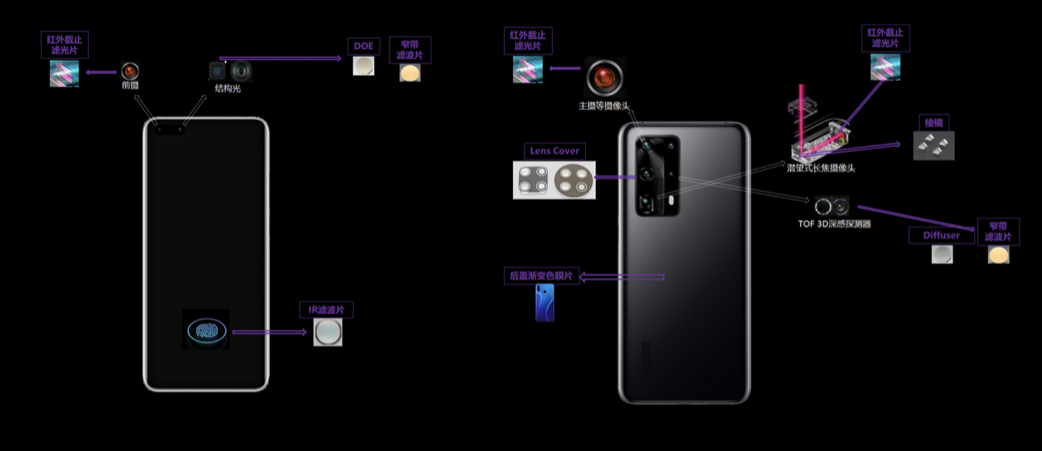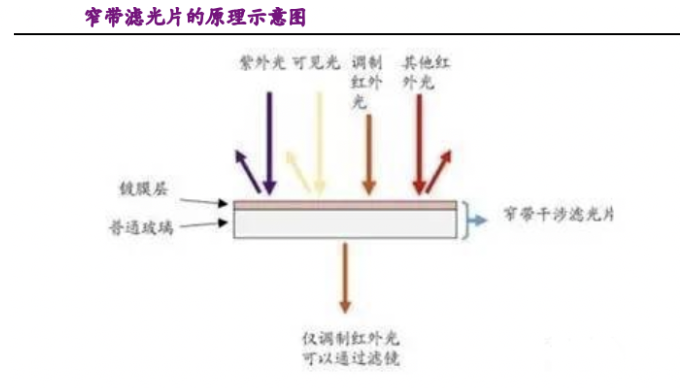Filtering is a necessary part of optics in imaging, recognition, etc., such as:
1, infrared cut-off filter: allows visible light through, cut-off or reflection of infrared light optical filters, products used in cell phones, cameras, car, PC, tablet PC, security monitoring and other imaging cameras.
2、Low-pass filter: Filter out the high-frequency light wave caused by Moore's stripes, color correction, etc. The products are used in digital cameras, video cameras, monitors.
3. Under-screen fingerprint filter: Realize green light transmission, the rest of the light cut-off.
4、Narrow Band Filter: Plated on the surface of glass and other substrates with a narrow bandpass film system in the near-infrared wavelengths, to achieve the function of high transmission of incident light in specific wavelengths and deep cutoffs in other wavelengths, and at the same time to meet the lower spectral shift at large angles of incidence. The products are used in distance sensors, 3D camera transmitter and receiver modules.
In recent years, with the development of cell phone multi-camera, periscope telephoto lens, front 3D structured light, rear TOF, under-screen fingerprint, rear glass panel and other technologies, the company's products in the cell phone applications continue to increase, the value of a single unit continues to increase.

Multi-camera: driving the continuous growth of infrared cut-off filters
IR-Cut filter is an optical filter that allows visible light to pass through and cuts off infrared light. When the light enters the lens, after refraction, the visible light and infrared light will be imaged on different target surfaces, the visible light will be imaged in color, and the infrared light will be imaged in black and white. When the visible light image is adjusted, the infrared light will form a false image on the target surface, affecting the color and quality of the image.

Infrared cut-off filters can be subdivided into two types, one is a reflective filter, the other is an absorptive filter. The most critical process for filters is coating, which needs to ensure the uniformity and consistency of the coating, which can be divided into vacuum coating and chemical coating. After coating, it can basically filter out the wavelength of light above 650nm to meet the basic needs of use.
IRCF made of blue glass as the base material coating is used to filter infrared light by absorption, which can filter the light of wavelength above 630nm and is more thorough; while IRCF made of ordinary glass as the base material coating is used to filter infrared light by reflection, and the reflected light is easy to cause interference, and the effect is poorer than that of the blue glass IRCF.

Narrowband filters, an important component in 3D cameras
Narrow Band Filter is an optical element that allows only a specific wavelength of light to pass through and filters out the rest of the wavelength.3D Sensing emits 940nm infrared light at the transmitter side, and the receiver side needs to filter out the rest of the wavelengths and accept only 940nm infrared light, so it needs to use a narrow band filter. The passband of the narrow band filter is relatively narrow, generally required in the center of the wavelength value of 5% or less.
Narrow-band filters are generally composed of two films with low and high refractive indices, stacked with dozens of layers, and the parameter drift of each film may affect the final performance; and narrow-band filter transmittance is very sensitive to the loss of the film, so it is very difficult to prepare filters with a high peak transmittance and a narrow half-bandwidth. There are various methods to prepare thin films, including chemical vapor deposition, thermal oxidation, anodic oxidation, sol-gel, atomic layer deposition (ALD), atomic layer epitaxy (ALE), magnetron sputtering, etc., and the performance of thin films prepared by different methods varies greatly.

Under-screen fingerprint: rapid penetration of under-screen fingerprints, expanding demand for optical filters
With the increasing penetration rate of the under-screen fingerprint identification program, the demand for optical filters has further risen.

